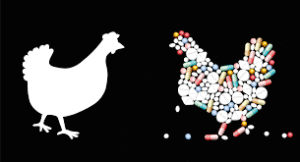
Antibiotic resistance (ABR) in poultry has become a major global public health concern, as it affects animal health, food safety, and human health. This problem arises when bacteria in poultry develop the ability to survive exposure to antibiotics, rendering treatments ineffective.
Below is a detailed breakdown:
1. Introduction
Antibiotics are widely used in poultry farming for:
Disease treatment (therapeutic use).
Disease prevention (prophylactic use).
Growth promotion (sub-therapeutic doses to increase weight gain).
Excessive or inappropriate use of antibiotics leads to antimicrobial resistance (AMR), where bacteria such as Salmonella, E. coli, and Campylobacter evolve into drug-resistant strains. These resistant bacteria can spread to humans through:
Consumption of contaminated poultry meat or eggs.
Direct contact with poultry.
Environmental contamination (water, soil, manure).
2. Causes of Antibiotic Resistance in Poultry
| Cause | Explanation |
|---|---|
| Overuse of antibiotics | Continuous, non-prescribed use for growth promotion or disease prevention creates selection pressure for resistant bacteria. |
| Incorrect dosage | Using too little or too much antibiotic promotes survival of resistant bacteria. |
| Poor biosecurity | Dirty housing, overcrowding, and poor ventilation lead to disease outbreaks, increasing antibiotic use. |
| Lack of veterinary supervision | Farmers often self-prescribe antibiotics without professional guidance. |
| Unregulated access to drugs | Over-the-counter availability of antibiotics in many developing countries worsens misuse. |
| Cross-contamination | Resistant bacteria spread through shared equipment, workers, or contaminated feed and water. |
3. Common Antibiotics Used in Poultry and Resistance Trends
| Antibiotic Class | Common Uses | Resistance Observed In |
|---|---|---|
| Tetracyclines | Growth promotion, respiratory diseases | E. coli, Salmonella |
| Fluoroquinolones (e.g., Enrofloxacin) | Gut and systemic infections | Campylobacter, Salmonella |
| Macrolides (e.g., Tylosin) | Respiratory diseases | Mycoplasma species |
| Beta-lactams (e.g., Amoxicillin) | General infections | E. coli, Salmonella |
| Sulfonamides | Coccidiosis control | Mixed resistance in enteric bacteria |
Critical problem:
Many of these drugs are also important in human medicine, so resistance in poultry directly threatens public health.
4. Impact of Antibiotic Resistance
A. On Poultry Farming
Increased mortality and production losses.
Higher treatment costs due to ineffective drugs.
Reduced meat and egg production.
B. On Human Health
Resistant bacteria like Salmonella and Campylobacter cause foodborne illnesses that are harder to treat.
Increased hospitalizations and treatment costs.
Rise of multi-drug resistant (MDR) pathogens such as E. coli.
C. Economic Impact
Trade restrictions on poultry products from countries with high AMR rates.
Loss of consumer trust and market value.
5. Transmission Pathways to Humans
Food chain: Undercooked meat or eggs containing resistant bacteria.
Direct contact: Farmers, slaughterhouse workers, and veterinarians are at high risk.
Environmental spread: Runoff water or manure contaminates soil and crops, creating a cycle of resistance.
6. Strategies to Control Antibiotic Resistance
| Approach | Action Steps |
|---|---|
| Improved farm management | Adequate space, proper ventilation, clean housing, and strict biosecurity. |
| Judicious antibiotic use | Use only when prescribed by a licensed veterinarian. |
| Vaccination programs | Reduce disease outbreaks and need for antibiotics. |
| Alternatives to antibiotics | Use of probiotics, prebiotics, essential oils, and herbal remedies to boost poultry immunity. |
| Regulation and policy | Government bans or restrictions on antibiotic use for growth promotion (e.g., EU ban). |
| Farmer education | Training farmers on AMR risks and responsible practices. |
| Surveillance programs | Monitoring resistance patterns in farms and food products. |
7. Case Study: Nigeria & Developing Countries
High antibiotic misuse due to unregulated access and weak veterinary services.
Commonly resistant bacteria: E. coli, Salmonella spp., and Klebsiella spp.
Lack of data and monitoring systems make it hard to track AMR trends.
Ongoing initiatives by FAO, WHO, and OIE to improve awareness and regulation.

8. Conclusion
Antibiotic resistance in poultry is not just an animal health problem; it is a One Health issue, linking animals, humans, and the environment.
Reducing resistance requires:
Responsible antibiotic use.
Better farming practices.
Strong government regulations.
Public awareness campaigns.

 CHRISTMAS PROMO: Get amazing discount on all equipment purchased from now till the end of the year.
CHRISTMAS PROMO: Get amazing discount on all equipment purchased from now till the end of the year.